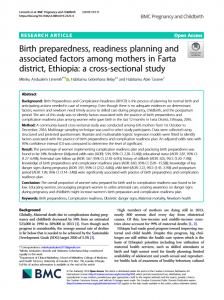
Background
Birth Preparedness and Complication Readiness (BP/CR) is the process of planning for normal birth and anticipating actions needed in case of emergency. Even though there is no adequate evidence on determinant factors, women and newborns need timely access to skilled care during pregnancy, childbirth, and the postpartum period. The aim of this study was to identify factors associated with the practice of birth preparedness and complication readiness plan among women who gave birth in the last 12 months in the Farta District, Ethiopia, 2016.
Method
A community-based cross-sectional study was conducted among 676 mothers from 1st October to December, 2016. Multistage sampling technique was used to select study participants. Data were collected using structured and pretested questionnaire. Bivariate and multivariable logistic regression models were fitted to identify factors associated with the practice of birth preparedness and complication readiness plan. An adjusted odds ratio with 95% confidence interval (CI) was computed to determine the level of significant.
Result
The percentage of women implementing complication readiness plan and practicing birth preparedness was found to be 34%. Residence [Adjusted odds ratio (AOR): 5.94, 95% CI: 2.28–15.46)]; educational status [AOR: 2.87, 95% CI: (1.27–6.49)]; Antenatal care follow up [AOR: 3.67, 95% CI: (2.10–6.41)]; history of stillbirth [AOR: 3.05, 95CI: (1.20–7.78)]; knowledge of birth preparedness and complication readiness plans [AOR: 8.83, 95% CI: (5.01–15.58)]; knowledge of key danger signs during pregnancy [AOR: 3.91, 95% CI: (2.52–6.06)], child birth [AOR: 2.22, 95CI: (1.45–3.39)] and postpartum period [AOR: 1.99, 95% CI: (1.14–3.48)] were significantly associated with practice of birth preparedness and complication readiness plan.
Conclusion
The overall proportion of women who prepared for birth and its complication readiness was found to be low. Educating women, encouraging pregnant women to utilize antenatal care, and creating awareness about danger signs during pregnancy and childbirth might increase women’s birth preparation and complication readiness plan.